 |
| Authenticated customized Sears Vallonia, Westerly, Rhode Island • 1933 Original home of Achille V. Piccolo, Jr. |
 |
| Sears Vallonia • 1932 Sears Modern Homes catalog |
Rarely are we treated to a set of blueprints for a Sears house. But, even more rare than that, is when the blueprints come with an entire set of letters of correspondence with Sears, regarding the purchase of a new homeowner's Sears house. In the case of this wonderful Vallonia model in Westerly, Rhode Island, the letters with Sears outline a number of customizations that the homeowner requested, as well as discussion all along the process, about everything from door sizes to support columns in the basement. I have all kinds of things to share with you in this blog post, so let's get to it!
The Vallonia is probably our number-1 most-often found Sears house around the country-- we have over 375 on our national database of Sears houses. This could be for several reasons:
- It was offered for a very long stretch in the catalogs, from about 1921-1940
- It is very distinctive, with those porch columns, and so, easy to recognize out in the wild
- Bungalows seem to have been a very sought-after style of home
- Taller second floor
- Looks like a taller dormer
- No dining room bumpout on the side we see as our left, when facing the house
- House widened by two feet
- Trademark Vallonia Sears porch columns not used
- Some extra windows
- Interior changes (hallway & staircase locations, and added French doors)
Before we look at what is different about this customized Vallonia, let's take a look at what we normally expect to see on the Vallonia.
The Vallonia, when introduced in 1921, had no side bumpout, had single windows in the peak on each side, and had two small, boxy windows in the dormer. In 1923, the bumpout was added, the peak windows were doubled, and the windows in the dormer were upped to a triple... three slim, taller windows. This makes the dormer look a little bigger, though I'm not sure whether or not it is.
 |
| Vallonia in 1921, and in 1925. (Click to enlarge) Please do not use any of the images posted here, without a clear and direct link to this blog post. |
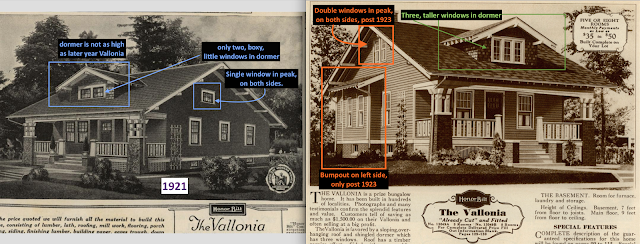 |
| Vallonia's new bumpout, and window changes, beginning in 1923. (Click to enlarge) Please do not use any of the images posted here, without a clear and direct link to this blog post. |
The elements that we always expect to see, are:
 |
| Please do not use any of the images posted here, without a clear and direct link to this blog post. |
- On the porch, the front door centered, with two windows on one side, and a single on the other
- The "trademark" Sears porch columns
- Three purlins (similar to rafter tails, these are support pieces that stick out of the structure at the ends) on the dormer, as well as a notched edge on the flat area of the front of the dormer... the barge board area
- Three purlins on the eaves of each part of the roof, leading to the center ridge board, at the peak
- A big thing: The roof line is straight down, front and back, with no "break"... no bend
If (like most of us) you aren't 100% sure of what purlins, rafter tails, and barge board are, here are a couple of helpful infographics:
 |
| source |
 |
| Source |
Now, I must add, that when a house has been re-sided with vinyl or aluminum siding, often the purlins and the notched edge of the barge board, are lost. The deep eaves are often cut down to closer to the house, too. Often, the windows in the dormer are replaced, and we can't tell whether there were originally two or three there. Sometimes, even the beautiful trademark Sears porch columns are boxed over in vinyl (oh, the horror!). Sometimes, the house is built with brick veneer, and so a different look is given to the porch columns, as well. But, we always recognize the centered front door, with double windows on one side, and a single on the other... well... except that, on occasion, that single is changed to a double! Ha! But, usually, there is enough left in place, that we can pick out a Vallonia on a first glance.
Let's take a look at a few, around the U.S. (click on any, to enlarge):
 |
| 1922 • Testimonial Vallonia, in Abington, Pennsylvania. This is an early one -- no bumpout on this side, and a single, boxy window up in the eave, but the purlins are all there. |
 |
| 1926 • Authenticated Vallonia in Berkley, Michigan All kinds of expected elements present here, though the windows in the dormer were changed. |
Customizing the Westerly, Rhode Island, Vallonia
Here, on the left side, we see that there is no bumpout for the dining room, on our Rhode Island Vallonia. Actually, the blueprints show that, instead of bumping out just the dining room, they enlarged the whole house a bit, by pulling out that whole side two feet. Also, the red lines here all show how much taller the house is. Note the extra space above the double windows in the peak, which normally sit high up in that area. Also, the height of the dormer is increased--there is much more space than usual, in that area above the windows. There is an additional little window upstairs, on the side, and the porch columns are nice, simple, chunky craftsman style:
The right side of the house, however, isn't much altered. It does, of course, show the same extra space above the upper double windows, and, there is another little window added on this side, up there, too, just as on the left side.
Inside the Westerly, RI Vallonia
The blueprints show us that the access to the hallway, and to the staircase, was changed for this house. Instead of having two openings in the side wall of the dining room-- one leading to the staircase, and one leading to the hallway-- our Westerly house has the staircase entrance moved elsewhere, and you walk right into the hall, as soon as you enter the house... instead of walking into the living room. Let me show you what I mean.
The early Vallonia's first-floor layout, had the access to the staircase, in the kitchen. The access to the hallway was from the dining room-- but, you walked right into the living room, when you opened the front door:
Post 1923, the "later" Vallonia (which means, for most all of its life as an offering in the Sears Modern Homes catalogs), both the access to the staircase, and the access to the hall, were from openings in that inner wall of the dining room:
In the catalog, Sears describes the access area for the stairs, and how, if you order plan A (no finished bedrooms upstairs), this will be set up as a closed door in the dining room, with stairs leading to the attic. But, with plan B (Mr. Piccolo's house is a customized version of plan B), they describe the bedrooms, sewing room, and closets you will have upstairs:
We can see these two dining-room openings, for stairs and hallway, in a real house, here in this Vallonia in Cincinnati, that was recently for sale (6336 Coffey St, Cincinnati, Ohio):
 |
| Mr. Piccolo's blueprints, showing Model No. 13049B Please do not use any of the images posted here, without a clear and direct link to this blog post. |
We can see these two dining-room openings, for stairs and hallway, in a real house, here in this Vallonia in Cincinnati, that was recently for sale (6336 Coffey St, Cincinnati, Ohio):
This Vallonia in Hyattsville, Maryland, has the expected size living room, so this is what you'd normally see when you walk into a non-customized Vallonia:
 |
| The normal size living room on a "regular" Vallonia, should be like this. There is a bedroom on the other side of the left wall. (source ) |
 |
| And, this is that same house, so we see how the living room heads into the dining room, and that's the kitchen, behind the dining room. |
Here is how Sears showed the Vallonia's living room, in the 1929 catalog:
Here is another Sears Vallonia, showing the two doorways off of the dining room, one for the stairway, and one to lead into the hall:
 |
| Sears Vallonia dining room, 81 Holland Avenue, White Plains, NY, showing standard doorways of of dining room. (Source) |
But, in Mr. Piccolo's customized Vallonia, in Westerly, Rhode Island you enter the house right into a hallway, not into the living room, and there is a set of French doors on the left, to access the living room... and the wall on the right, here, is the left wall of that front bedroom.
 |
| Please do not use any of the images posted here, without a clear and direct link to this blog post. |
 |
| Please do not use any of the images posted here, without a clear and direct link to this blog post. |
See? Here is the "jog" over to the right, so you can get to the bathroom, and head into the back bedroom, and get to the staircase:
 |
| Please do not use any of the images posted here, without a clear and direct link to this blog post. |
 |
| Please do not use any of the images posted here, without a clear and direct link to this blog post. |
 |
| All around the house, Mr. Piccolo opted for clean, simple, New England lines, I'd say. Please do not use any of the images posted here, without a clear and direct link to this blog post. |
Full shots of pages of the blueprints, again, the black marks were from Sears, showing changes in the width of the house.
 |
| Please do not use any of the images posted here, without a clear and direct link to this blog post. |
 |
| Black marks indicating the 2 extra feet of width. Please do not use any of the images posted here, without a clear and direct link to this blog post. |
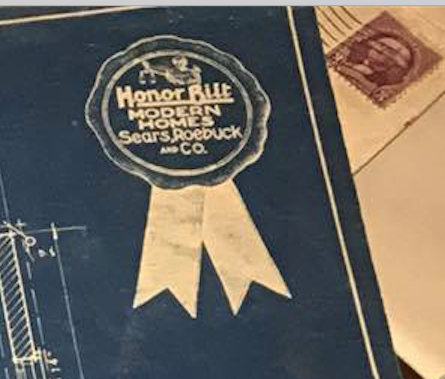 |
| That's the Honor Bilt seal! Please do not use any of the images posted here, without a clear and direct link to this blog post. |
As mentioned, the current owners of this house inherited not only the blueprints, but pages and pages of letters from Sears, responding to questions and requests from the man who was to be the new homeowner, Mr. Achille V. Piccolo, Jr.
Achille Piccolo, Jr., was born in 1909 in Westerly, of parents who had come to the United States from Italy --his father, in 1899, and his mother, Margherita, in 1903. His father worked as a granite cutter, and they all lived together in a house on this same street, at a different house number ... so, you'll see that the letters from Sears, are directed to Achille (A.V. Piccolo) at 52 Ledward Avenue, because that is where he was living with his parents at the time... the house itself, when built, sat at No. 40 Ledward Avenue, though it now has the house number 26.
Here is a photo of Achille, with his parents, probably around 1914, considering his age (the Ancestry account that made this family tree, labeled this as approximately 1924, but Achille would have been 15 by then, and he surely is not 15 in this photo). That's little Achille, in the center, flanked by his parents:
 |
| The Piccolo family, on Ledward Avenue, Westerly, Rhode Island, circa 1914. |
Achille appears to have been an only child. And, his parents must have been very proud to have been able to send him to college. There are several images of him from "The Cauldron-1930" a college yearbook from Northeastern University, in Boston, shown in a family tree on Ancestry.com. I'd like to thank Thomas Marchisa, for sharing this publicly on the Marchisa-Toman family tree.
 |
| Achille V. Piccolo, Jr., in 1930, three years before building his Sears Vallonia. |
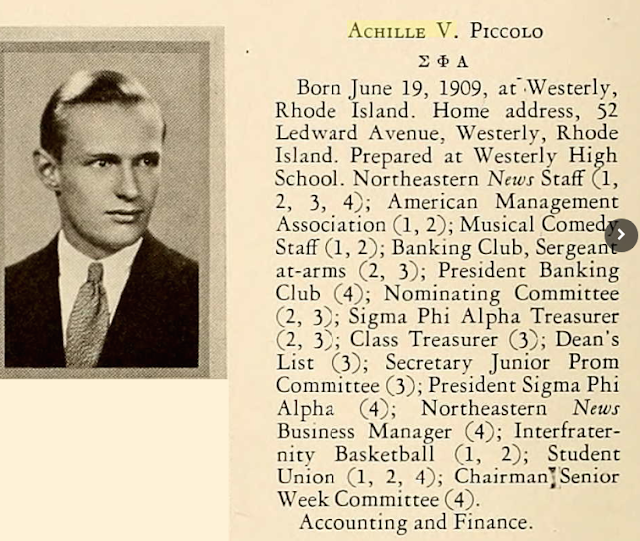 |
| From the 1930 edition of The Cauldron, from Northeastern University, in Boston. |
 |
| That's Achille, up there on the left, back row. This was the Banking Club. |
Throughout the 1940s and into the late 1950s, Achille is listed in city directories still at the address of his Sears Vallonia. I believe that he worked as an accountant in the tax department for the state, working in Providence, and living in Westerly. His father, Achille V. Piccolo, Sr., passed away in September of 1934, and his mother, Margaret (Margherita) came to live with him in the Sears house. Probably in about 1937, he married the former Edna Coon.
Letters From Sears
To begin his process, Mr. Piccolo must have met with Sears, perhaps at their Boston office, and outlined all of the customizations that he wanted. He also chose to have the house sent "not cut and fitted", so the lumber was not pre-cut and labeled, as it would be, if it were a standard kit. We are not certain, but I suspect that it may have been more common, if you customized the size of the house, to have not-pre-cut lumber... it just makes sense, because otherwise, Sears would have had to have re-set all of the machinery to cut just for your changes. Perhaps they did do that, but I just suspect that they did not... and, here is a case to support that thought. It was also less expensive to get not-cut-to-fit wood, but you still would end up with labor costs having your carpenter, or a sawmill, do that for you.
This seems to be the first letter from Sears-- outlining the special choices Mr. Piccolo made, and addressing the payment issues. It is dated May 15, 1933 (for all of these letters, click if you would like to see a larger version).
Letters From Sears
To begin his process, Mr. Piccolo must have met with Sears, perhaps at their Boston office, and outlined all of the customizations that he wanted. He also chose to have the house sent "not cut and fitted", so the lumber was not pre-cut and labeled, as it would be, if it were a standard kit. We are not certain, but I suspect that it may have been more common, if you customized the size of the house, to have not-pre-cut lumber... it just makes sense, because otherwise, Sears would have had to have re-set all of the machinery to cut just for your changes. Perhaps they did do that, but I just suspect that they did not... and, here is a case to support that thought. It was also less expensive to get not-cut-to-fit wood, but you still would end up with labor costs having your carpenter, or a sawmill, do that for you.
This seems to be the first letter from Sears-- outlining the special choices Mr. Piccolo made, and addressing the payment issues. It is dated May 15, 1933 (for all of these letters, click if you would like to see a larger version).
 |
| Please do not use any of the images posted here, without a clear and direct link to this blog post. |
 |
| Please do not use any of the images posted here, without a clear and direct link to this blog post. |
This letter outlines some more of the interior options for the house:
 |
| Please do not use any of the images posted here, without a clear and direct link to this blog post. |
 |
| La Tosca door hardware! Please do not use any of the images posted here, without a clear and direct link to this blog post. |
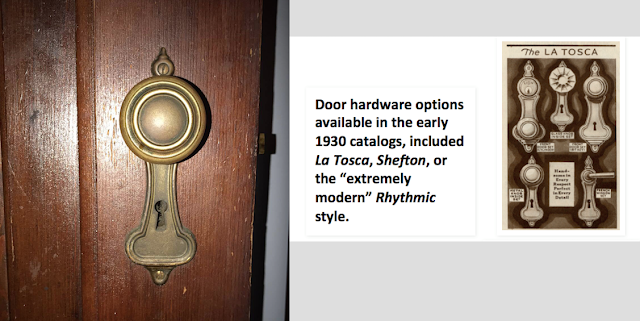 |
| And, here it is: La Tosca door hardware on the house, and in the catalog. Please do not use any of the images posted here, without a clear and direct link to this blog post. |
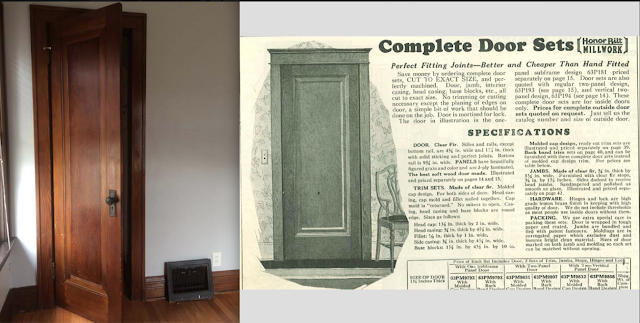 |
| This is the style of interior doors that was ordered, though this door is actually from a Winona in Affton, Missouri. |
 |
| And, here is the mirrored door that was chosen for that hall closet, under the stairs. |
 |
Click to see the full letter.
Please do not use any of the images posted here, without a clear and direct link to this blog post. |
 |
| This is from the Valley Forge group of lighting fixtures. Please do not use any of the images posted here, without a clear and direct link to this blog post. |
Here is a chandelier from the Valley Forge group lighting fixtures, in the 1936 General Merchandise catalog, but it differs somewhat from the one in the house. Perhaps there was a simpler version offered in 1933:
 |
| From page 509 of the Spring 1936 general merchandise catalog No. 172L. |
 |
| Please do not use any of the images posted here, without a clear and direct link to this blog post. |
 |
| Please do not use any of the images posted here, without a clear and direct link to this blog post. |
 |
| Please do not use any of the images posted here, without a clear and direct link to this blog post. |
 |
| Click to see full letter Please do not use any of the images posted here, without a clear and direct link to this blog post. |
Adjusted size of sills, and choice of lally columns instead of girder posts:
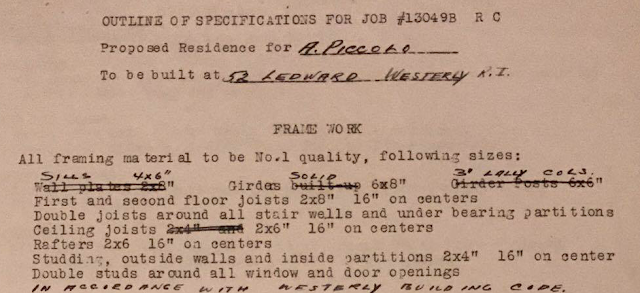 |
| Please do not use any of the images posted here, without a clear and direct link to this blog post. |
These are lally columns, vs girder posts, in case you didn't know (I didn't):
 |
| And another letter regarding the change to lally columns, and their extra cost. Please do not use any of the images posted here, without a clear and direct link to this blog post. |
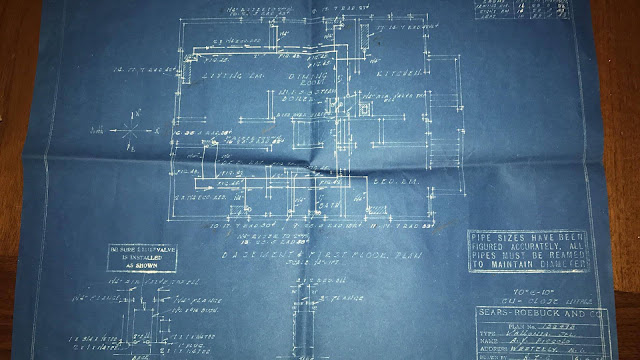 |
| Please do not use any of the images posted here, without a clear and direct link to this blog post. |
 |
| There is Mr. A. V. Piccolo's name, right there on the corner of the blueprints! Please do not use any of the images posted here, without a clear and direct link to this blog post. |
 |
| Please do not use any of the images posted here, without a clear and direct link to this blog post. |
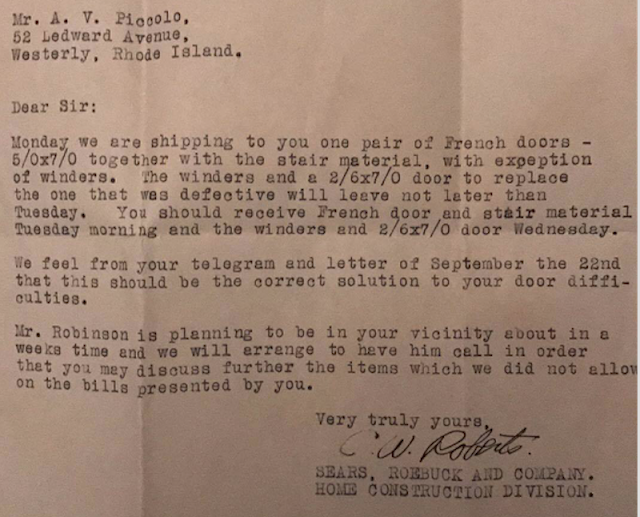 |
| Regarding the addition of French doors. Please do not use any of the images posted here, without a clear and direct link to this blog post. |
 |
| Please do not use any of the images posted here, without a clear and direct link to this blog post. |
 |
| Please do not use any of the images posted here, without a clear and direct link to this blog post. |
And, this one is pretty humorous... clearly, the Sears rep thought that the requirements that Mr. Piccolo felt that the building inspector expected, were not necessary (but, they'd meet them, nonetheless): "You certainly must have a fine building inspector to do business with insomuch as his requirements are more severe than the city of Boston and surrounding towns, and, in fact, any other community in which I've done business." Ha!
 |
| See close-up below, of section regarding the "fine building inspector" Please do not use any of the images posted here, without a clear and direct link to this blog post. |
 |
| Please do not use any of the images posted here, without a clear and direct link to this blog post. |
And, something that we did not know that Sears would do: they asked you to put a sign in your yard, I assume saying something like, "Another Sears house being built here!" (I don't really know what the sign said, of course. ;) )
 |
| Please do not use any of the images posted here, without a clear and direct link to this blog post. |
As you probably understand, Sears was meticulous in providing exactly what the homeowner needed, to build the house according to their instructions. So, they provided the correct amount of nails, screws, and bolts, and told you where to use them. If you (or your carpenter) used, for example, the bolts, in the wrong spot, you wouldn't have what you needed, when you got to where those bolts had been intended. That seems to be the case in Mr. Piccolo's house, as there is one letter addressing his apparent request for more bolts:
 |
| Please do not use any of the images posted here, without a clear and direct link to this blog post. |
On July 3, they sent another letter regarding the bolts, and they addressed the door issue... finally deciding that 7' doors had actually been ordered, and would be sent:
 |
| Please do not use any of the images posted here, without a clear and direct link to this blog post. |
 |
| So, they finally agreed to send the 7 foot doors. Please do not use any of the images posted here, without a clear and direct link to this blog post. |
 |
| Please do not use any of the images posted here, without a clear and direct link to this blog post. |
You also see mention of a small, "plumbing access door" (indicated above, with white arrow). Here is that plumbing access area:
 |
| It's wonderful how even access areas to get to plumbing, were detailed in nice wood. Please do not use any of the images posted here, without a clear and direct link to this blog post. |
 |
| Please do not use any of the images posted here, without a clear and direct link to this blog post. |
 |
| Please do not use any of the images posted here, without a clear and direct link to this blog post. |
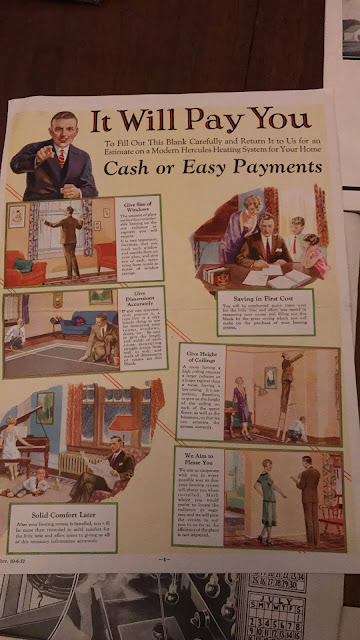 |
| Please do not use any of the images posted here, without a clear and direct link to this blog post. |
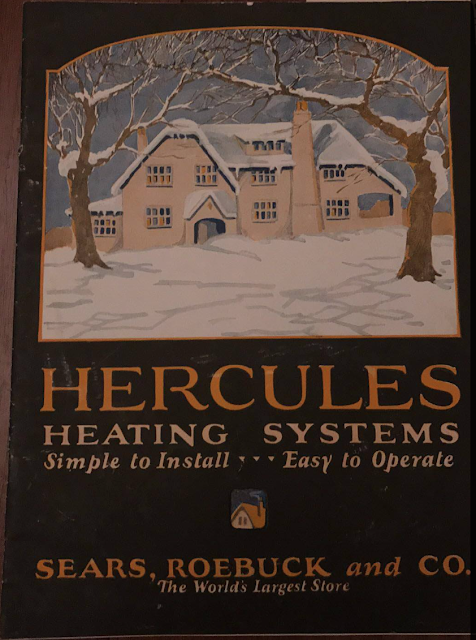 |
| Please do not use any of the images posted here, without a clear and direct link to this blog post. |
 |
| Please do not use any of the images posted here, without a clear and direct link to this blog post. |
 |
| Please do not use any of the images posted here, without a clear and direct link to this blog post. |
So... one last look at Mr. Piccolo's customized Vallonia, on Ledward Avenue, in Westerly, Rhode Island:
 |
| 26 Ledward Avenue, Westerly, Rhode Island Please do not use any of the images posted here, without a clear and direct link to this blog post. |
•••••••••••••••••••••••••••••••••••••••••••••••••••••••••
For more information on who we are, and what we do, visit our website: SearsHouses.com


















Wow, seems like Mr Piccolo was somewhat hard to please near the end! But as you were saying, he does have a right to make sure his requests are met. Nice, informative post and great pictures as well! I don't think I would have been able to identify this custom Vallonia from streetview. How lucky that the current owners kept all that information -- it's a treasure trove indeed. :)
ReplyDeleteA treasure trove, for our never-ending treasure hunt!
DeleteHi Andy Piccolo! I'm so happy to hear from you, and really glad that you ran across this post! All of the Sears-house related material for the post came from the current owners, who inherited it all, when they bought the house. They contacted us on our Sears Modern Homes Facebook Page .
DeleteDo you, by any chance, have any other photos of the Piccolo family, perhaps when they were older? And, any photos that have the house in the background, inside or out? If so, I'd love to see them! You can email me direcetly at SearsHouseSeeker@gmail.com
Thanks!
Judith Chabot
Well done, I'm impressed, thank you.
ReplyDeleteI own a Vallonia - loved reading this - thank you!! Trace Yeatts
ReplyDeleteHey do you offer copies of the blueprints
ReplyDeleteNo, we don't have any blueprints.
DeleteA treasure trove indeed!! Great job, Sears House Seeker :)
ReplyDeleteThanks for your story about the Westerly home. We are Vallonia homeowners in Alexandria VA. The blueprints for the house were in the house, albeit with a fair amount of damage due to insects. The prints will remain with the house at such time as we move out of it. We've been in it for nearly 40 years. We have worked to retain much of the bungalow's original charm by not making major stylistic changes inside even while doing some renovations. The family that built it in the late 20s eventually clad the siding with faux stone, but it still looks good.
ReplyDeleteThis is a wonderful overview of the home. Our family grew up in a Vallonia in southern Ohio and believe it was an early 1920's vintage. The floor plan was slightly modified in that the front door was biased a bit to the right and led into a good-sized hall with staircase on the right hand wall. Against the staircase my Mother's upright piano stood and there was a hall closet at the back of the hall. Entering the front door you turned immediately left into the living room which entry was bracketed by two beautiful pillars. The heating unit shown in your post was exactly ours although upgraded to gas when we lived there - it was later replaced with a modern unit. Our folks bought it in 1959 and my Mother lived in it until about 1990. Along the right side of the concrete block foundation near the middle of the house was the window for coal - our basement remained unfinished and the coal bin still had leftover coal in the corner which was half-walled off from the rest of the basement. As a teenager I put a ham radio station in the basement with a curtain to wall off the heating unit. It was a great home for a family with four kids and Grandma who came to live with us. Fond memories...
ReplyDeleteI find this fascinating. I recently purchased a home that is obviously a Sears home,and from the outside looks exactly like the early vallonia. But the inside layout is quite different. Instead of a dining room and a hall, mine has 4 relatively equal rooms on the first floor, with the staircase between the kitchens and the other back room. Most of the woodwork is original. I would really like to know where I could get more information.
ReplyDeleteI would love to see the house, and help you out. Unfortunately, I have no way of contacting you, without an email address. Please feel free to contact me directly at SearsHouseSeeker@gmail.com, and provide an address of the house, so that we can look at it through Google streetview and real esate listings.
Deletei grew up in a early vallonia in Hempstead NY on long island...we had 3 bedrooms upstairs (besides the one downstairs) and a half bath upstairs
ReplyDeletenyintegrity@gmail.com